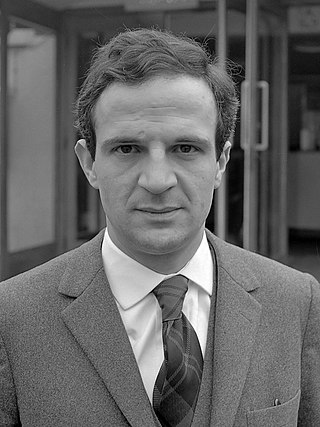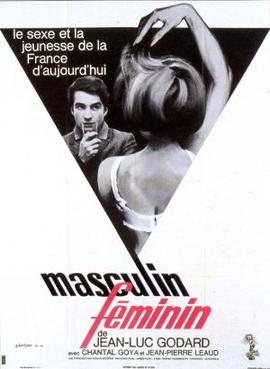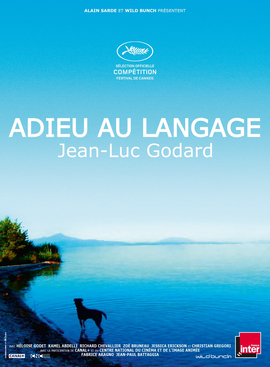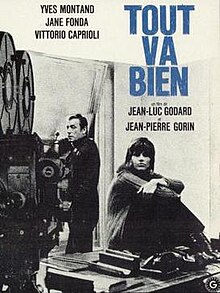
François Roland Truffaut was a French filmmaker, actor, and critic. He is widely regarded as one of the founders of the French New Wave. With a career of more than 25 years, he is an icon of the French film industry.

Jean-Luc Godard was a French and Swiss film director, screenwriter, and film critic. He rose to prominence as a pioneer of the French New Wave film movement of the 1960s, alongside such filmmakers as François Truffaut, Agnès Varda, Éric Rohmer and Jacques Demy. He was arguably the most influential French filmmaker of the post-war era. According to AllMovie, his work "revolutionized the motion picture form" through its experimentation with narrative, continuity, sound, and camerawork. His most acclaimed films include Breathless (1960), Vivre sa vie (1962), Contempt (1963), Band of Outsiders (1964), Alphaville (1965), Pierrot le Fou (1965), Masculin Féminin (1966), Weekend (1967) and Goodbye to Language (2014).

The fourth wall is a performance convention in which an invisible, imaginary wall separates actors from the audience. While the audience can see through this "wall", the convention assumes the actors act as if they cannot. From the 16th century onward, the rise of illusionism in staging practices, which culminated in the realism and naturalism of the theatre of the 19th century, led to the development of the fourth wall concept.

A jump cut is a cut in film editing that breaks a single continuous sequential shot of a subject into two parts, with a piece of footage removed to create the effect of jumping forward in time. Camera positioning on the subject across the sequence should vary only slightly to achieve the effect. The technique manipulates temporal space using the duration of a single shot—fracturing the duration to move the audience ahead. This kind of cut abruptly communicates the passing of time, as opposed to the more seamless dissolve heavily used in films predating Jean-Luc Godard's Breathless, which extensively used jump cuts and popularized the technique in the 1960s. For this reason, jump cuts are considered a violation of classical continuity editing, which aims to give the appearance of continuous time and space in the story-world by de-emphasizing editing, but are sometimes nonetheless used for creative purposes. Jump cuts tend to draw attention to the constructed nature of the film. More than one jump cut is sometimes used in a single sequence.
Cinéma vérité is a style of documentary filmmaking developed by Edgar Morin and Jean Rouch, inspired by Dziga Vertov's theory about Kino-Pravda. It combines improvisation with use of the camera to unveil truth or highlight subjects hidden behind reality. It is sometimes called observational cinema, if understood as pure direct cinema: mainly without a narrator's voice-over. There are subtle, yet important, differences between terms expressing similar concepts. Direct cinema is largely concerned with the recording of events in which the subject and audience become unaware of the camera's presence: operating within what Bill Nichols, an American historian and theoretician of documentary film, calls the "observational mode", a fly on the wall. Many therefore see a paradox in drawing attention away from the presence of the camera and simultaneously interfering in the reality it registers when attempting to discover a cinematic truth.

Day for Night is a 1973 romantic comedy-drama film co-written and directed by François Truffaut. The metafictional and self-reflexive film chronicles the troubled production of a melodrama, and the various personal and professional challenges of the cast and crew. It stars Jacqueline Bisset, Valentina Cortese, Jean-Pierre Aumont, Dani, Alexandra Stewart, Jean-Pierre Léaud and Truffaut himself.
The New Wave, also called the French New Wave, is a French art film movement that emerged in the late 1950s. The movement was characterized by its rejection of traditional filmmaking conventions in favor of experimentation and a spirit of iconoclasm. New Wave filmmakers explored new approaches to editing, visual style, and narrative, as well as engagement with the social and political upheavals of the era, often making use of irony or exploring existential themes. The New Wave is often considered one of the most influential movements in the history of cinema.
Jean-Pierre Gorin is a French filmmaker and professor, best known for his work with Nouvelle Vague luminary Jean-Luc Godard, during what is often referred to as Godard's "radical" period.

Pierrot le Fou is a 1965 French New Wave romantic crime drama road film written and directed by Jean-Luc Godard, starring Jean-Paul Belmondo and Anna Karina. The film is based on the 1962 novel Obsession by Lionel White. It was Godard's tenth feature film, released between Alphaville and Masculin, féminin. The plot follows Ferdinand, an unhappily married man, as he escapes his boring society and travels from Paris to the Mediterranean Sea with Marianne, a girl chased by OAS hitmen from Algeria.

Masculin Féminin is a 1966 French New Wave film directed by Jean-Luc Godard. An international co-production between France and Sweden, the film stars Jean-Pierre Léaud, Chantal Goya, Marlène Jobert, Catherine-Isabelle Duport, and Michel Debord.

La Chinoise, ou plutôt à la Chinoise: un film en train de se faire, commonly referred to simply as La Chinoise, is a 1967 French political docufiction film written and directed by Jean-Luc Godard about a group of young Maoist activists in Paris.
Letter to Jane is a 1972 French postscript film to Tout Va Bien directed by Jean-Luc Godard and Jean-Pierre Gorin and made under the auspices of the Dziga Vertov Group. Narrated in a back-and-forth style by both Godard and Gorin, the film serves as a 52-minute cinematic essay that deconstructs a single news photograph of Jane Fonda in Vietnam. This was Godard and Gorin's final collaboration.
The Dziga Vertov Group was formed around 1969 by politically active filmmakers including Jean-Luc Godard and Jean-Pierre Gorin. Their films are defined primarily for Brechtian forms, Marxist ideology, and a lack of personal authorship.
Metacinema, also meta-cinema, is a mode of filmmaking in which the film informs the audience that they are watching a work of fiction. Metacinema often references its own production, working against narrative conventions that aim to maintain the audience's suspension of disbelief. Elements of metacinema include scenes where characters discuss the making of the film or where production equipment and facilities are shown. It is analogous to metafiction in literature.

Jean-Luc Godard was a French-Swiss film director, screenwriter and film editor whose career spanned nearly seventy years. He directed, wrote, produced and edited many films. The following attempts to be a comprehensive filmography.
Soft and Hard is a video piece created by Jean-Luc Godard and Anne-Marie Miéville in 1985. It runs for 52 minutes and features their conversations about filmmaking and television.
Agnès Godard is a French cinematographer. She is most famous for her long-running collaboration with filmmaker Claire Denis. For her work, she has won a César Award.
Tout Va Bien may refer to:

Goodbye to Language is a 2014 French-Swiss narrative essay film written and directed by Jean-Luc Godard. It stars Héloïse Godet, Kamel Abdeli, Richard Chevallier, Zoé Bruneau, Jessica Erickson and Christian Grégori and was shot by cinematographer Fabrice Aragno. It is Godard's 42nd feature film and 121st film or video project. In the French-speaking parts of Switzerland where it was shot, the word "adieu" can mean both goodbye and hello. The film depicts a couple having an affair. The woman's husband discovers the affair and the lover is killed. Two pairs of actors portray the couple and their actions repeat and mirror one another. Godard's own dog Roxy Miéville has a prominent role in the film and won a prize at the Cannes Film Festival. Like many of Godard's films, it includes numerous quotes and references to previous artistic, philosophical and scientific works, most prominently those of Jacques Ellul, Aleksandr Solzhenitsyn and Mary Shelley.
Wind from the East is a 1970 film by the Dziga Vertov Group, a radical filmmaking cooperative that, at its core, included Jean-Luc Godard and Jean-Pierre Gorin. As with most films from this period in Godard's career, directing credit was given to the collective and not himself or other individual filmmakers.











